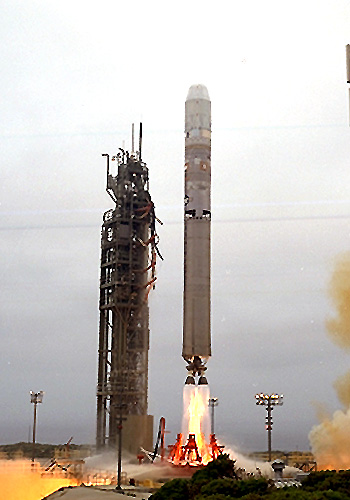

 The Titan II vehicles are decommissioned intercontinental
ballistic missiles that have been refurbished and equipped with hardware required for use
as space launch vehicles. The Martin Marietta Astronautics Group was awarded a contract in
January 1986 to refurbish, integrate, and launch fourteen Titan II ICBMs for government
space launch requirements. These modifications allow for launches of medium-class payloads
to polar orbit.
The Titan II vehicles are decommissioned intercontinental
ballistic missiles that have been refurbished and equipped with hardware required for use
as space launch vehicles. The Martin Marietta Astronautics Group was awarded a contract in
January 1986 to refurbish, integrate, and launch fourteen Titan II ICBMs for government
space launch requirements. These modifications allow for launches of medium-class payloads
to polar orbit.
The Titan family was established in October 1955, when the U.S. Air Force awarded the
then Martin Company a contract to build an intercontinental ballistic missile (ICBM). It
became known as the Titan I, the nation’s first two-stage ICBMs and first underground
silo-based ICBM. Over 140 Titan II ICBMs, once the vanguard of America’s strategic
deterrent force, were built. Titan IIs also were flown in NASA’s Gemini manned space
program in the mid-1960s.
Tasks involved in converting the Titan II ICBMs into space launch vehicles include
modifying the forward structure of the second stage to accommodate payload; manufacturing
a new 10-foot diameter payload fairing with variable lengths plus payload adapters;
refurbishing the Titan’s liquid rocket engines; upgrading the inertial guidance
system; developing command, destruct and telemetry systems; modifying Vandenberg Air Force
Base, Calif., Space Launch Complex-4 West to conduct the launches; and performing payload
integration.
The Air Force successfully launched the first Titan II space launch vehicle from Vandenberg on Sept. 5, 1988.
The Titan II space launch vehicle is a two-stage liquid fueled booster, designed to provide a small-to-medium weight class capability. It is able to lift approximately 4,200 pounds into a polar low-Earth circular orbit.
Deactivation of the Titan II ICBM system began in July 1982 and was completed in June 1987. Deactivated missiles are in storage at Davis-Monthan Air Force Base, Ariz.
Specifications |
| Launch site: First stage: Second stage: Guidance:
Engine: |
Vandenberg Air Force Base, Calif. Length: Length: Inertial with Digital Computer Diameter: Refurbished Titan II ICBM Engines |
70 feet 10 feet 474,000 pounds (vacuum) 24 feet
|
All Former
Titan II Alumni, Please sign my Guest Book!
Here
(Current as of March 1997)